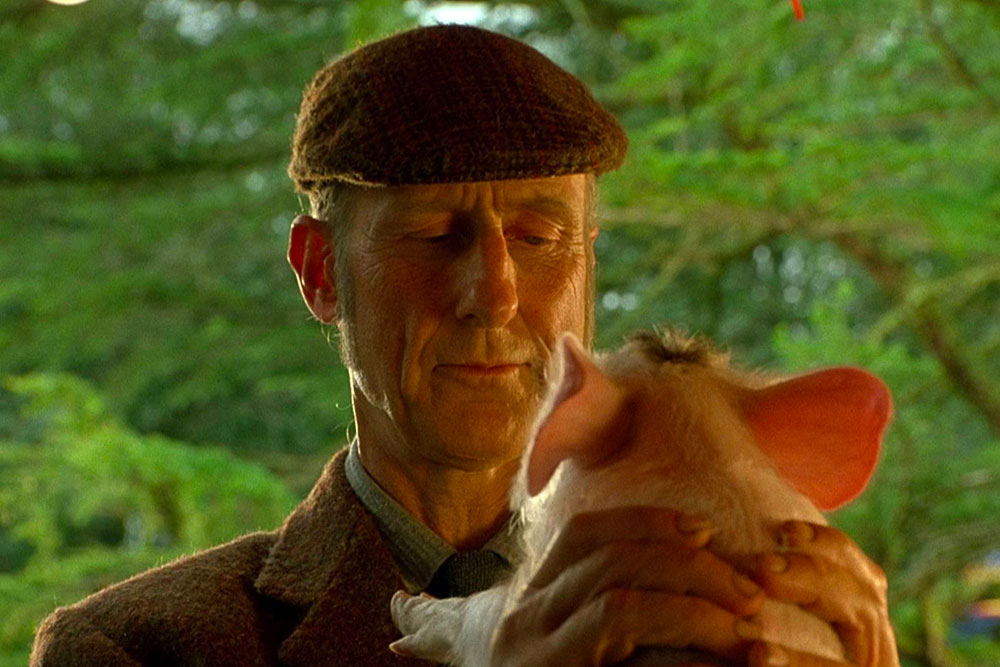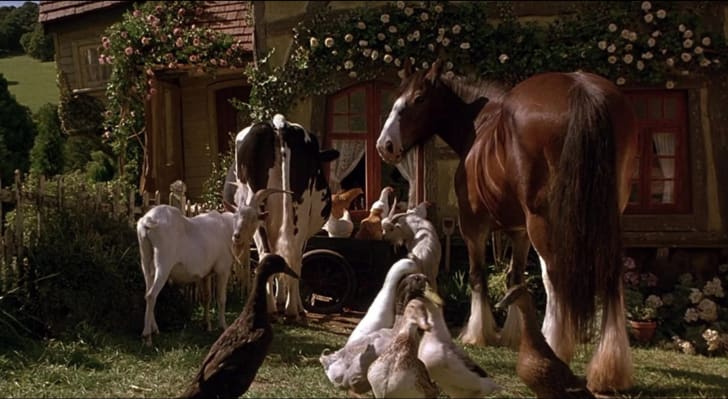That'll do, George
Babe is an wonderful film; we can start and maybe even end there. But I am reviewing it in the context of George Miller’s filmography, so I’d like to firstly consider the question: Is Babe a film by George Miller? He is not the director; that is Chris Noonan. Noonan and Miller share writing credit for the screenplay, which adapts the 1983 chapter book The Sheep-Pig. These days, Noonan and Miller dispute how much credit Miller deserves for the final product: Miller suggests he was the director in all but official credit, controlling the film’s look and tone; Noonan counters that Miller has tried to claim the project as his own in the wake of the film’s success but was rather just an advisor overseeing from a distance. The truth is probably somewhere in between, or, more accurately, a little bit of both. (The Tim Burton-Henry Selick creative partnership for The Nightmare Before Christmas comes to mind as an analog: In both cases, the more famous visionary got the ball rolling and stuck around as producer and consultant, but the nuts-and-bolts credit belongs to the less famous director, though Selick has since independently staked his claim as great where Noonan hasn’t.)
Take away everything that’s happened in the 30 years since. Put yourself in the mindset of a George Miller fan in 1995 and ask yourself: Is this a Miller film? The obvious counterfactual reaction is: Of course it isn’t! He’s the Mad Max guy! Ozploitation and car chases and freaky dystopias! Even his non-Mad Max films, The Witches of Eastwick and Lorenzo’s Oil, are aimed at grown-ups (one a dark comedy, the other a heavy drama). And yet, I think it is very plausibly something touched with Miller’s inspiration: Mad Max: Beyond Thunderdome’s second half was an Amblin-style adventure co-starring feral children. Miller is obviously fascinated by the tone of childlike whimsy; even his epic Mad Max 2: The Road Warrior has a cartoonish heart. More broadly, Miller demonstrated through the early ‘90s a remarkable elasticity, always trying something in a new storytelling space with each one of his directorial efforts. A “living storybook” like Babe is a plausible next step for the director. (Miller would also spend the next 20 years making kids’ movies, so the entire thought exercise wondering whether he’d make a family-friendly film is a bit facile.)
Two traits in particular make Babe feel like a Miller picture. The first is the setting: the film was shot largely in Australia. Unless I’m mistaken, Babe’s national setting is never explicitly stated; it reads as a nonspecific blend of English, American, and Australian. The novel it’s based off of takes place in England, and Babe radiates with the A.A. Milne-esque coziness of Edwardian England (tinted with ‘50s kitsch); the animals and imagery are a blend of American farmland and Australian shepherding.

The second Miller hallmark is just how fully formed and overflowing with creativity the film’s vision and worldbuilding are. Like all of Miller’s early films, the sheer imagination and vivid texture are a tidal wave: Memorable sets, amusing production flourishes, distinct characters, and flavorful argot color every minute of screentime.
But that brings me to the qualities of Babe that are distinctly non-Millerish: Babe is terrifically focused, even restrained. Those are two words you’d never use to describe a Miller picture. (Sure enough, the Miller-directed Babe sequel flies loose in a way Babe doesn’t.) And so my conclusion is that Babe is really the best of both worlds: The wild inventiveness of Miller reined in and shaped by Noonan. I would feel a little more confident in this claim if I had seen any more of Noonan’s work, and if any of it had anywhere near the reputation of Babe, but alas — he’s made only one other feature film, a 2006 biopic of children’s author Beatrix Potter.
Babe tells the story of a young pig saved from slaughter and won at a local fair by a farmer named Arthur Haggett (James Cromwell). Babe (Christine Cavanaugh) joins Haggett’s farm as a clueless interloper on the animal social order, inadvertently disrupting the calm. The farm is a pastoral portrait that has a lot of Charlotte’s Web in its DNA, plus just a smidge of Animal Farm. Babe is taken in by the Haggett’s Border Collies, though the dad, Rex (Hugo Weaving) is very speciesist and harsh, like Kerchak in Disney’s Tarzan.

Babe bumbles through some misadventures, mainly centered around a feisty duck named Ferdinand (Danny Mann), before he starts inhabiting sheepdog tendencies from his Border Collie adoptive family. The quiet Haggett sees a spark of something special in Babe; the pig finds that he can influence the sheep by being empathetic to them in a way a barking dog could never be. It culminates in a sheepdog competition in which Haggett submits Babe as a competitor, prompting Air Bud-style consternation over whether the rulebook permits a sheep-pig competitor. This is a children’s movie, so you can probably guess whether Babe wins the trophy despite his unconventional stature. (And the film’s famous closing line is “that’ll do, pig” in case you need another hint.)
The sturdy yet episodic narrative is not what makes Babe so special, but the execution therein. There’s a magic to Babe, a glowing, bespoke warmth that has been frequently and accurately described as a children’s picture book come to life. In fact, the film adopts a framing display of a book cover and turning page chapter titles. The production has a slight diorama quality to it, but richly detailed and lived-in, occasionally even expressionistic (like at the pig farm during the opening segment). Singing barn mice serve as a Greek rodent chorus transitioning us between chapters. The colors are bright and vibrant, especially the rolling green pastures.

Most importantly, the animals themselves are marvels of movie magic. I remain genuinely astonished how Noonan and co. achieved such expressive and lifelike creatures. The voice-synced mouths are almost entirely seamless, with well-disguised animatronics reportedly the mechanism. To my eyes, it’s just as believable to me that Miller and Noonan found real life talking animals; they’re that good, especially in comparison to the shitty CGI that pervades most 21st century family features.
The cast is excellent, too. The voice acting is good all around, and the humans leave a real impression. Two highlights are Cromwell, stoic and strong but almost completely taciturn, and Magda Szubanski as his gossiping wife. Cromwell lends a nobility to the material that serves as a backbone in contrast to the heightened animal shenanigans, and Szubanski offers some of that signature Australian humor, motor-mouthed and slightly mean.
I frankly have no complaints of note about Babe. At 91 minutes, I can’t even gripe about the runtime! I could probably nitpick a few narrative choices and thematic inconsistencies, but they’re so minor and washed away by the film’s flowing charm that they’re not worth the digital ink. Babe is essentially flawless. That’s not the same as saying it’s a “Masterpiece” — whether it’s overfamiliarity or something about its tone and uncontroversial kindness, I just don’t adore it the way I do plenty of other, more flawed films. Maybe that makes me spiteful, holding back that last rating point. Regardless of my hesitation at dropping the M-word, this is one of the great live action children’s films of the past several decades, a contender for Miller’s best movie, and a genuine achievement in filmmaking. Babe is a wonderful film.
- Review Series: George Miller
Is It Good?
Exceptionally Good (7/8)
Dan is the founder and head critic of The Goods. Follow Dan on Letterboxd. Join the Discord for updates and discussion.

